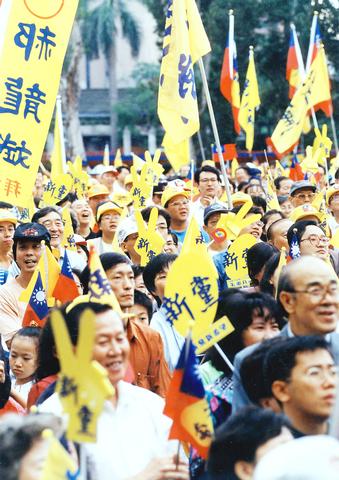For most political parties the year-end legislative elections will be a race to keep or gain as many seats as possible. For the pro-unification New Party the greatest challenge will be to survive.
Today, the party holds just seven seats in the legislature, having plummeted from 21 in 1995, a time when some believed the young opposition party was poised to become the country's third largest political force.

PHOTO: TAIPEI TIMES FILE PHOTO
Also, since last year's formation of the People's First Party (PFP) after the presidential elections and Lien Chan's (
Those who choose to stay blame external factors for the party's decline -- such as the reported poaching of members by the PFP. For many, the strife-prone party has outlived its life expectancy.
"The New Party should engage in some soul-searching and examine why one member after another breaks away and none want to come in," said Yao Li-ming (
In 1990, a group of reform-minded KMT lawmakers formed a faction called the New KMT Alliance. Their vocal criticism of the establishment earned them applause from grassroots supporters but estrangement from the KMT leadership. In 1993, six members from the alliance quit the KMT to form the New Party, frustrated at what they saw as a dangerous drift by then president Lee Teng-hui (李登輝) toward independence -- and the prevalence of corruption in government.
"With the creation of the New Party, voters no longer have to choose between two evils -- between the corrupt KMT and the pro-independence DPP," Jaw Shaw-kung (
In 1994, Jaw ran for the first directly elected Taipei mayoralty. Eloquent and charismatic, Jaw drew hundreds of thousands of supporters to his rallies.
Hsu Huang-ming (
Although Jaw did not win the mayoralty, he helped send 11 fellow colleagues to the Taipei City Council, ending the KMT's majority control in the capital city for the first time. Under his leadership, the New Party won 21 seats in the 1995 legislative elections with 14 percent of the votes.
But before long, feuding erupted among its elite members.
In line with the party's charter, those holding public office were also the party's leaders, who themselves bickered over how to run the party.
Some, including former convener Chou Yang-san (周陽山), preferred a conservative approach, while others, notably Jaw, favored radical tactics.
"It was not right that a select few were able to set the party's rules and alter them all the time," said a former New Party lawmaker, who spoke on condition of anonymity.
At the insistence of Jaw, the party held a primary to decide its candidates for the 1998 legislative polls.
The bold experiment turned out to be a fiasco. Several contestants were accused of dishonest electioneering and some left the party after failing to be nominated.
The infighting took a heavy toll on the New Party. In the end, the party captured just 10 legislative seats with 7 percent of the vote in 1998.
Wang Chien-shien (王建 ), the party's Taipei mayoral candidate, finished a distant third with just 2.97 percent of the total vote. An overwhelming number of New Party supporters rallied behind KMT nominee Ma Ying-jeou (馬英九), a more promising contender.
Comprised mostly of ethnic mainlanders and their offspring, the party did not tolerate any attempt to split Taiwan from China.
To this end, party stalwarts frequently aimed their fire at Lee, whom they branded as a closet pro-independence advocate. Indeed, members like Elmer Fung (馮滬祥) gained their fame from vehement Lee-bashing.
"Parochial and exclusive, no wonder the party has problems building support beyond Taipei," noted one lawmaker, who gave up his party badge in early 1999.
In fact, with so much hatred directed towards one individual some say jokingly that once Lee disappears from the political limelight, the New Party will also cease to exist.
Trying to attract media attention, the New Party in 1999 surprised the nation by nominating a non-party member -- the flamboyant and controversial writer Li Ao (李敖) -- as their candidate in the 2000 presidential campaign. This despite calls by key party officials to pledge support for independent James Soong, an ethnic mainlander.
Soong, the former Taiwan provincial governor, proved a formidable candidate, missing the presidency by a margin of 2 percentage points. Two weeks later, he founded the PFP, which triggered yet another exodus of members from the New Party.
Earlier this month, legislator Feng Ting-kuo (馮定國) made a high-profile defection to the PFP to run on its ticket for the year-end elections. Although former colleagues have lined up to condemn his desertion, many are expected to follow suit in order to keep their political careers alive.
To claim proportional representation, the New Party must amass at least 5 percent of the votes in December. Failing that, the party will be disqualified from receiving government funds.
Experts have described the test as extremely tough, if not untenable. "It is impossible for the New Party to pass the threshold in light of its latest showing," said Edward Chen (陳一新), who teaches American Studies at Tamkang University. The party polled 0.13 percent in the presidential elections last year.
"That explains why even its leaders chose to leave," Chen noted.

SECURITY: As China is ‘reshaping’ Hong Kong’s population, Taiwan must raise the eligibility threshold for applications from Hong Kongers, Chiu Chui-cheng said When Hong Kong and Macau citizens apply for residency in Taiwan, it would be under a new category that includes a “national security observation period,” Mainland Affairs Council (MAC) Minister Chiu Chui-cheng (邱垂正) said yesterday. President William Lai (賴清德) on March 13 announced 17 strategies to counter China’s aggression toward Taiwan, including incorporating national security considerations into the review process for residency applications from Hong Kong and Macau citizens. The situation in Hong Kong is constantly changing, Chiu said to media yesterday on the sidelines of the Taipei Technology Run hosted by the Taipei Neihu Technology Park Development Association. With

A US Marine Corps regiment equipped with Naval Strike Missiles (NSM) is set to participate in the upcoming Balikatan 25 exercise in the Luzon Strait, marking the system’s first-ever deployment in the Philippines. US and Philippine officials have separately confirmed that the Navy Marine Expeditionary Ship Interdiction System (NMESIS) — the mobile launch platform for the Naval Strike Missile — would take part in the joint exercise. The missiles are being deployed to “a strategic first island chain chokepoint” in the waters between Taiwan proper and the Philippines, US-based Naval News reported. “The Luzon Strait and Bashi Channel represent a critical access

‘FORM OF PROTEST’: The German Institute Taipei said it was ‘shocked’ to see Nazi symbolism used in connection with political aims as it condemned the incident Sung Chien-liang (宋建樑), who led efforts to recall Democratic Progressive Party (DPP) Legislator Lee Kun-cheng (李坤城), was released on bail of NT$80,000 yesterday amid an outcry over a Nazi armband he wore to questioning the night before. Sung arrived at the New Taipei City District Prosecutors’ Office for questioning in a recall petition forgery case on Tuesday night wearing a red armband bearing a swastika, carrying a copy of Adolf Hitler’s Mein Kampf and giving a Nazi salute. Sung left the building at 1:15am without the armband and apparently covering the book with a coat. This is a serious international scandal and Chinese

COUNTERINTELLIGENCE TRAINING: The ministry said 87.5 percent of the apprehended Chinese agents were reported by service members they tried to lure into becoming spies Taiwanese organized crime, illegal money lenders, temples and civic groups are complicit in Beijing’s infiltration of the armed forces, the Ministry of National Defense (MND) said in a report yesterday. Retired service members who had been turned to Beijing’s cause mainly relied on those channels to infiltrate the Taiwanese military, according to the report to be submitted to lawmakers ahead of tomorrow’s hearing on Chinese espionage in the military. Chinese intelligence typically used blackmail, Internet-based communications, bribery or debts to loan sharks to leverage active service personnel to do its bidding, it said. China’s main goals are to collect intelligence, and develop a